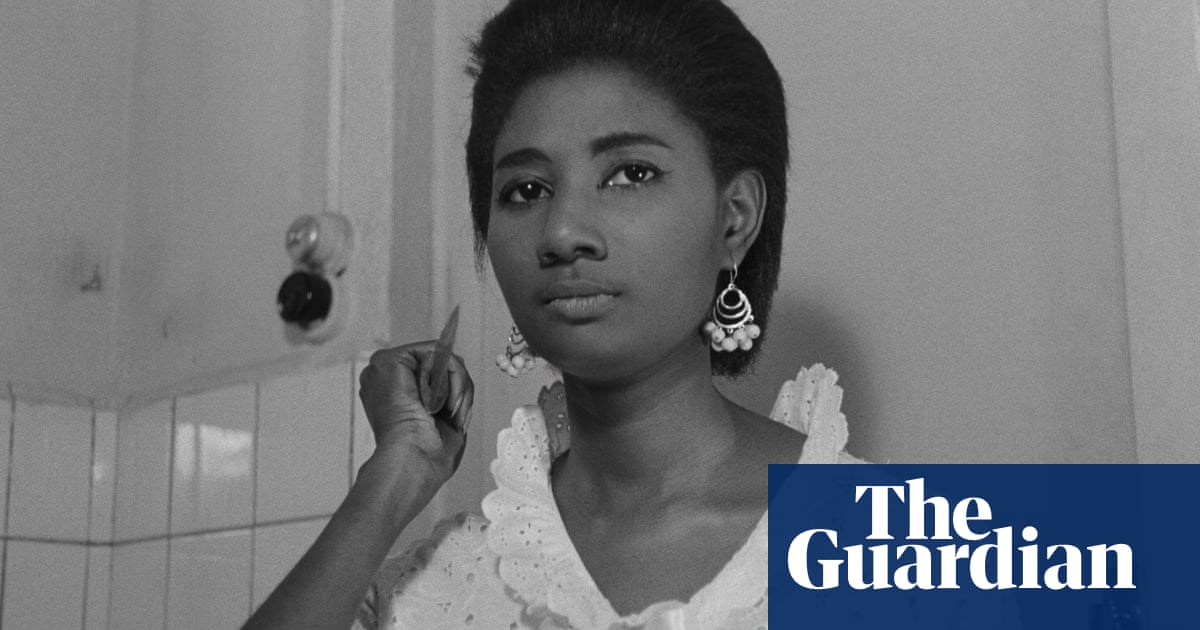
While the exhibition at London’s Raven Row gallery is called PerAnkh: The June Givanni Pan African Cinema Archive, the Black British film curator, activist and archivist who created it is hesitant about positioning herself front and centre. “I don’t want it to sound like it’s all me, me, me,” she worries. “My name is part of it because I worked as a curator for many years and collected work throughout the non-digital era, which developed into this archive.”
Though she wants the films, documents, artworks and objects she has preserved to be the focus of people’s attention – from an installation of the earliest audiovisual works by the Black Audio Film Collective to new works by the Chimurenga collective from South Africa – Givanni is more than worthy of the spotlight. When she received the British independent film awards’ grand jury prize in 2021, the organisers said that she had “made an extraordinary, selfless and lifelong contribution to documenting a pivotal period of film history”.
Born in British Guiana 72 years ago, Givanni moved to the UK aged seven and was immediately underestimated. “They put me with the five-year-olds because I was Black and I’d come from the Caribbean,” she remembers. “My mum went to the school twice before they moved me up to my age range.” As an adult, Givanni collaborated with some of the most significant figures and institutions in pan-African cinema and across “different territories, different continents”. She kept adding elements to her collection, she says, “because I needed to use them for subsequent programmes and as part of building a body of knowledge and a whole series of resources that can be shared with others.”
Lack of preservation has meant many of pan-African cinema’s masterworks have disappeared. In America alone, it is estimated more than 80% of Black films from the silent era are lost, and technological advances endanger film further. While physical film has a potential shelf life of hundreds of years, digital preservation requires constant migration to keep up with changing technology. The impact of digitisation makes “everyone’s work more challenging”, Givanni admits. “And nobody knew it was going to go that way otherwise they might have done things very differently.”
Givanni has faced changes in technology, politics and culture since she began in the early 80s. The first film festival she worked on was called Third Eye, inspired by the Latin American Third Cinema movement which set out to challenge Europe and North America’s dominance in film. For Givanni, the festival provided “an area to develop our own ideas about representation and taking charge. Pan-African cinema has always been a cinema of resistance. I can’t tell you how inspiring it was that there were all these people out there doing things that really chimed with what I thought should be happening.”
Givanni fortified this “cinema of resistance” across institutions and roles almost as varied as the archive itself. She programmed festivals on five continents; worked for Greater London Council’s ethnic minorities unit and the Independent Television Commission; ran the BFI’s African Caribbean film unit and co-edited Black Film Bulletin, which relaunched in 2021 as a quarterly collaboration with Sight and Sound magazine, and has celebrated the under-sung work of film-makers like Menelik Shabazz, Horace Ové and Julie Dash.
The archive proliferated as she “was working independently for the most part. And I would keep the posters, the physical press packs, VHSs and cassettes.” The spirit of pan-Africanism was a guiding light, connecting all cultures that originated on the continent without treating them as a monolith. Givanni explains, “When I say pan-African, it’s not just the African continent; it’s the entire diaspora. All those significant histories are interconnected and cinema is very much part of that.”
Choosing how to represent that history at Raven Row, with selections from an archive that now surpasses 10,000 items, was a gargantuan task. But Givanni immediately knew she wanted to include “a poster of the Mogadishu film week, given to me at my first attendance at the Fespaco film festival in 1985 by a Somali film-maker. Now people mention Somalia and they don’t picture these vibrant and strategic cultural events taking place there.”
The exhibition forms an alternative history, acknowledging the vitality and ingenuity that are under-appreciated or studiously ignored by so many. And the value of physical films and objects is beyond just what they depict. “At the Havana film festival I bought a collection of silkscreen posters that will be exhibited. Lots of art can be seen digitally, but to see a silkscreen poster, the texture and the colour of it – there’s an experience of culture and artefacts that goes beyond digital representation.”
Beyond allowing the public to admire key objects from Givanni’s collection, the exhibition is structured around a programme of films from the likes of Sarah Maldoror and Ousmane Sembène (the mother and father of African cinema). There is also an archive studio and reading room in the spirit of the exhibition’s title, PerAnkh – an Egyptian term for “a place of learning and memory”. While Givanni has always been at the forefront of the decolonisation of culture, engaging with the archive invites you to join her there. It acts as a living organism, forever growing and reframing the outlook of those who encounter it. For Givanni, “It always symbolised how you can challenge people’s mindset about what the world is”.
PerAnkh: The June Givanni PanAfrican Cinema Archive is at Raven Row, London, until 4 June












